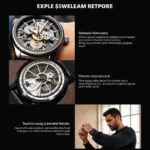Wiring a light switch correctly is crucial for a safe and functional electrical system. This guide provides a step-by-step approach to wiring different types of light switches, ensuring you can confidently tackle this common household task.
Understanding Different Types of Light Switches
Before you begin, it’s essential to identify the type of light switch you’re working with. Common types include single-pole, three-way, four-way, and dimmer switches. Each type serves a different purpose and has a unique wiring configuration.
Single-Pole Switches
Single-pole switches are the most common type, used to control a light fixture from a single location. They have two terminals and are relatively simple to wire.
Three-Way Switches
Three-way switches are used to control a light fixture from two different locations, such as the top and bottom of a staircase. They have three terminals and require a specific wiring arrangement.
Four-Way Switches
Four-way switches are used in conjunction with two three-way switches to control a light fixture from three or more locations. They have four terminals and are the most complex to wire.
Dimmer Switches
Dimmer switches allow you to adjust the brightness of a light fixture. They come in various types, including rotary, slide, and touch dimmers.
Gathering the Necessary Tools and Materials
Having the right tools and materials is essential for a successful wiring project. You’ll need:
- Screwdrivers (flathead and Phillips)
- Wire strippers
- Needle-nose pliers
- Voltage tester
- Electrical tape
- Wire connectors (wire nuts)
- The appropriate light switch for your needs
Step-by-Step Guide to Wiring a Single-Pole Switch
- Turn off the power: Locate the circuit breaker that controls the light fixture and switch it off. Use a voltage tester to confirm the power is off.
- Prepare the wires: Strip about ½ inch of insulation from the ends of the wires.
- Connect the ground wire: Connect the bare copper or green ground wire from the switch box to the green grounding screw on the switch.
- Connect the hot wire: Connect the black hot wire from the power source to the black screw terminal on the switch.
- Connect the switch leg: Connect the black wire leading to the light fixture to the other black screw terminal on the switch.
- Connect the neutral wires: Connect the white neutral wires from the power source and the light fixture together using a wire connector.
- Secure the switch: Carefully tuck the wires into the switch box and secure the switch to the box using the mounting screws.
- Restore power: Turn the circuit breaker back on and test the switch.
Wiring Three-Way and Four-Way Switches
Wiring three-way and four-way switches is more complex and requires careful attention to the wiring diagram. Consult a qualified electrician if you are unsure about any aspect of the wiring process.
Troubleshooting Common Issues
- Light doesn’t turn on: Check the circuit breaker, bulb, and wiring connections.
- Switch feels hot: This could indicate a loose connection or a faulty switch.
- Sparks or smoke: Immediately turn off the power and consult an electrician.
Conclusion
Wiring a light switch can be a straightforward task with the right guidance. By following the steps outlined in this guide and taking necessary safety precautions, you can successfully wire various types of light switches and enhance the functionality of your home. Remember to consult a qualified electrician if you encounter any difficulties.
FAQ
- Do I need to turn off the power before wiring a light switch? Absolutely! Turning off the power is crucial for safety.
- Can I wire a three-way switch myself? While possible, it’s more complex than a single-pole switch. If you’re unsure, consult an electrician.
- What type of wire should I use for light switches? Typically, 14-gauge wire is used for 15-amp circuits, and 12-gauge wire for 20-amp circuits.
- How do I know if my switch is faulty? A hot switch, flickering lights, or a switch that doesn’t work consistently can indicate a faulty switch.
- What should I do if I see sparks or smoke? Immediately turn off the power and contact a qualified electrician.
- Can I use a dimmer switch with any type of bulb? No, some bulbs are not compatible with dimmer switches. Check the bulb packaging for compatibility.
- Where can I find a wiring diagram for my specific switch? The switch packaging or manufacturer’s website should have a wiring diagram.
Need Help? Contact TRAVELCAR!
For any transportation needs in Hanoi, contact TRAVELCAR. We offer a range of services, including airport transfers and city tours in comfortable 16, 29, and 45-seater vehicles. Our 24/7 customer service team is ready to assist you. Call us at 0372960696, email TRAVELCAR[email protected], or visit our office at 260 Cầu Giấy, Hà Nội.
Explore more Hanoi travel tips and resources on our website. Check out our articles on [link to another blog post|hanoi-street-food-guide|Hanoi Street Food Guide] and [link to another blog post|best-hanoi-markets|Best Hanoi Markets].

